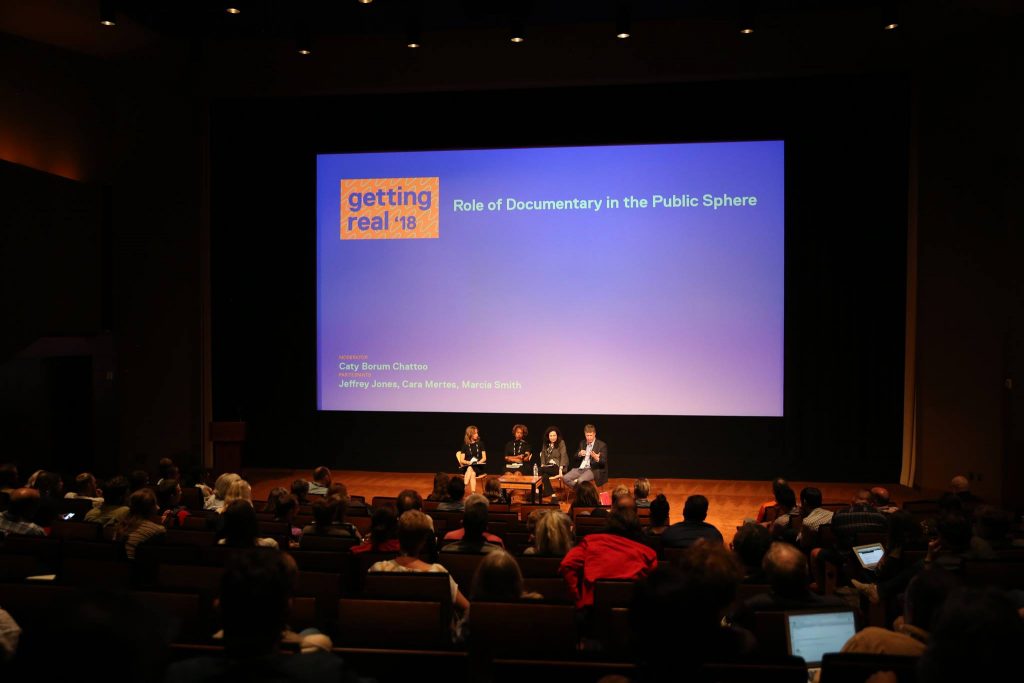
"The Role of Documentary in the Public Sphere" panel at Getting Real 18--Left to right: Moderator Caty Borum Chattoo, Center for Media and Social Impact; Marcia Smith, Firelight Media; Sally Jo Fifer, ITVS; and Jeffrey Jones, Peabody Awards. Photo courtesy of AMPAS.
This article was originally published in IDA’s website, www.documentary.org
Getting Real 2018 used complementary sessions to examine documentaries as tools for public knowledge and action as well as the policies, best practices and standards that enable documentary-making and distribution.
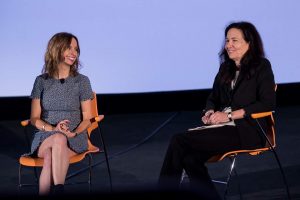
Moderator Caty Borum Chattoo, Center for Media and Social Impact with Sally Jo Fifer of ITVS
In her “mini-keynote” that she delivered the day before “The Role of Documentary in the Public Sphere,” ITVS CEO Sally Jo Fifer called on the field to project the standards and values of independent documentary in an increasingly commercialized, dynamic and blended marketplace by holding true to the long-held commitment to diversity, equity and inclusion. “Our purpose stays clear, no matter what disruptions come our way,” she asserted. “It is vital to keep the balance between public, nonprofit and market partners healthy in this disruptive economy to make sure that the boom does not damage our ecosystem and what we stand for, and that public and philanthropic funds are there whether the tide is in or out.”
Marcia Smith, president of Firelight Media, cast a cold eye on the emerging marketplace, warning that a growing appetite for documentary films does not “translate into a financial model.” She asked the critical question: “As the platforms are proliferating and the money is flowing, will the stories of communities of color continue to broaden?”
Answering her own question, she maintained that in a “commercial world…driven by celebrity” and skewed notions of the audience, “there is no given that if the amount of money expands, that the range of stories that are told will expand, or that the filmmakers who are able to tell the stories will be diverse.”
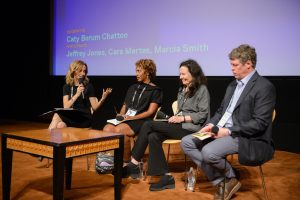
“The Role of Documentary in the Public Sphere” panel at Getting Real 18–Left to right: Moderator Caty Borum Chattoo, Center for Media and Social Impact; Marcia Smith, Firelight Media; Sally Jo Fifer, ITVS; and Jeffrey Jones, Peabody Awards. Photo courtesy of IDA Getting Real.
Moderator Caty Borum Chattoo, director of American University’s Center for Media and Social Impact and author of the forthcoming The Blackfish Effect & Other Stories: Documentaries and Social Change in the Information Age, framed the session in the context of “fraught times,” fake news, social polarization and political dysfunction—a now-more-than-ever need for social documentaries to engage, inform and equip people in the struggle for truth and trust.
What, then, is the role of independent documentaries when politicians fail to address issues that matter, when news companies cut back on investigative reporting, when media barrage audiences with unintelligible images of catastrophe that make them feel helpless and hopeless?
Documentary makers need to step up to fill the gaps, said Firelight’s Smith. “If we had a real press, the obligations and the burden on documentaries would be different,” she noted. We can exercise our “moral authority” by daring to take on topics and stories that are not addressed and to make films that “help us understand each other’s humanity at the highest level.”
Two videos that the panelists screened illustrated critical propositions for the field. First, documentary makers have earned the credibility and have the production experience to intervene in public debates. And second, the coalescence of documentaries on critical issues has a combined impact greater than any single film, and often signals emerging social movements.
Smith showed Story of Access, by director/producer and Firelight co-founder Stanley Nelson, which Starbucks commissioned for a national anti-bias training retreat for employees at the company’s 8,000 stores, following a racially charged incident in a Philadelphia store. The project, she said, demonstrated that “independent documentarians can speak with authority in this period when people are questioning institutions.”
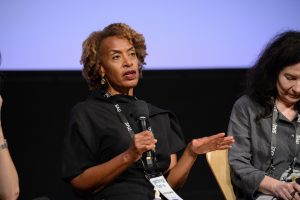
Marcia Smith of Firelight Media, speaking on the “Role of Documentary in the Public Sphere” session. Photo courtesy of AMPAS
According to Smith, Firelight agreed to make the film for Starbucks with just a two-week notice because it was an opportunity “to use our documentary skill to provide some context for reflection,” and “to highlight the very ordinary experience that people of color have when they navigate the public space.”
The production reflected Nelson’s decades of work in making corrective narratives and recovering histories lost, deleted and denied. It conveyed two essential messages: “The right to be respected in public spaces was at the heart of the civil rights movement, [and] changing the law doesn’t always change reality and being allowed in doesn’t mean being welcomed.”
The audience applause was thunderous.
Jeffrey Jones, director of the George Foster Peabody Awards, next showed a compilation of clips on race and criminal justice from 16 winners and nominees over the past four years. Jones made the case that the video, narrated by Peabody board chair Eric Deggans, NPR’s first full-time TV critic and author of Race-Baiter: How the Media Wields Dangerous Words to Divide a Nation, demonstrated the power of “accumulated narratives.”
In her introduction to the panel, Borum Chattoo called the Peabody Awards a “cultural validator” that identifies the stories that “guide our public conversation.” Jones maintained that in “an era of contestation, when facts are being rejected,” the accumulated narratives represented by the awards are “making claims for the truth” and “mobilizing greater empathy and understanding,” exercising a power that adds up “across genres and platforms.”
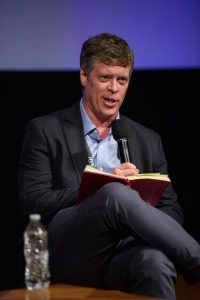
Jeffrey Jones, Director Peabody Awards.
Peabody also has made video compilations of its winners on immigration, gun violence and women’s issues. Fifer said she saw narrative accumulation in the 60 ITVS films of its Women and Girls Lead project well before the #MeToo movement, as well as in a wave of films on mass incarceration.
The audience applauded a final question about federal regulation and public interest obligations of media: “Who among us is doing the research, drafting policies, educating the field, and representing the field with regulators and legislators?”
“We need really smart policy people in our corner right now,” the questioner asserted. “It’s important that we stand for our values and make our voices heard and defend the right to transparency and accountability.”
Smith added, “If we can envision an ecosystem that is more equitable, that is more directed, that is more strategic, the documentary movement can help the whole society move forward.”
Fifer urged the audience to “stand up for public” in all its forms, from public media to public libraries, and to be inspired by the 10-year campaign that established ITVS.
A report published by CMSI in 2009, Public Media 2.0: Dynamic, Engaged Publics, written by Jessica Clark and Patricia Aufderheide, provided compass points for our vision of an inclusive public culture. It mapped the emerging landscape of “choice, conversation, curation, creation and collaboration” and called for “federal, state and local investment in creating the public sphere made possible by the digital revolution.” That, they wrote, included “an accessible, stable and reliable platform,” support for “staff and partnerships to build public engagement,” and “tax benefits for nonprofit organizations and commercial companies for creating public media.”
Looking back on the report for the Ford Foundation-funded Future of Public Media project at AU’s Center for Media and Social Impact, Aufderheide reflected, in an email interview before the conference, “The challenge of figuring out where public space is in our evolving media landscape is even more urgent than it was in 2009. It’s exciting to see the central concept of user-centric media weather well and be so useful today.”
Asked what the report got wrong, Aufderheide noted, “I think we did not come to grips with the implications of a surveillance society, in which networked communities are leveraged for political and financial gain.”
How the documentary field advocates for itself in the current media environment was the focus of “What Does Advocacy for Documentary Look Like?” Moderator Jack Lerner, an intellectual property and copyright attorney, law professor and point-person on the IDA Board for policy, maintained in his introduction that “Advocacy has shaped the documentary field in very profound ways.” It has been “proactive” in establishing funding streams and outlets for documentary work, and by setting industry standards, as in fair use. Advocacy also has been “reactive,” according to Lerner, as filmmakers are defended in court and legal precedents are protected.
Since the 1970s, documentary makers have fought to carve out a place for independent production on public television. In addition to ITVS and its Independent Lens series, signature successes include POV and the Minority Consortia. Preserving and building on this legacy is difficult in the best of times, but what do we do now in legislatures and courts to defend and advance the field?
Gordon Quinn, Kartemquin co-founder and artistic director, and a leader in advocacy for documentary for five decades, provided an urgent history lesson. His core message: “In our field, we have won big victories.” He explained that filmmakers have organized to address public television for more than 40 years, from the Coalition for New Public Affairs Programming in the mid-’70s to the recent success of the Indie Caucus in blocking the efforts by PBS and WNET to move POV and Independent Lens out of their Monday-night time slots.
“It was a move that would kill the series,” Quinn emphasized, adding that organization and strategic communication was used to overturn the decision. “With 3,000 names on a petition, we brought out our constituency—filmmakers and the people we make our films about. That’s what advocacy can do.”
Quinn and panelist Borum Chattoo explained that the documentary community’s advocacy for a central role in public media influenced programming decisions, production practices, and the careers of directors, producers and professionals throughout the field. Quinn highlighted Aufderheide and Peter Jaszi’s work in establishing best practices for fair use, saying it “created a sea-change in what you can do as a documentary filmmaker.” Educating documentary makers, insurance companies, funders and outlet gatekeepers in the interpretation of the law has freed filmmakers to make critical works of history, satire and media literacy.
But, as Lerner explained after the panel, it requires a concentrated effort by IDA, Kartemquin and other stakeholders to renew the Library of Congress exemption to the Digital Millennium Copyright Act, which allows documentary makers to rip content under fair use guidelines. Lerner said that the Copyright Office will soon announce whether the current exemption, which only applies to documentary filmmakers, will be modified to include all filmmakers.
The case study of producer/director Joe Berlinger’s court battle with Chevron Corporation over outtakes from his 2009 film Crude illustrated the risks of taking on a story of litigation and the importance of defending filmmakers with “reporter’s privilege and First Amendment rights.”
Berlinger resisted a subpoena for all 600 hours of footage documenting the struggle of indigenous people in Ecuador and their lawsuit against Chevron subsidiary Texaco for dumping toxic waste and “creating a cancer death zone” because he said he felt an “obligation to his subjects not to give over the footage to their enemy.”
Berlinger was trapped in Chevron’s case claiming fraud by the lawyer for the Ecuadorians. He lost the case –in which he had to release his footage to Chevron — on appeal when “the court determined I was not a journalist,” he reflected. “The movie cost $1.2 million and the lawsuit cost $1.3 million.”
Berlinger assumed his insurance would cover the legal expenses, but “Chubb informed me that they would not fund subpoena resistance, only subpoena compliance,” which is the cost of delivering the content. After IDA, DGA, Robert Redford, Norman Lear and “the whole industry” came out in his support, Berlinger said, Chubb settled to avoid a boycott.
Fearing a chilling effect on investigative filmmakers, Berlinger joined the IDA board “after 25 years in my own silo” because he wanted to give something back. Filmmakers, he said, need to be educated on the lessons he learned.
Lerner agreed that filmmakers need to adopt “operational best practices,” from insurance policies to a written independence agreement with subjects. Berlinger, backed by Lerner, called for a legal defense fund, “that we can do…in concert with the insurance companies,” which have an interest in controlling costs. Lerner also suggested recruiting a “cadre of lawyers willing to work pro-bono.”
Borum Chattoo called for a hub of information on policy issues that would equip documentary makers for action.
Elspeth Revere, a former MacArthur Foundation executive responsible for documentary funding, was concerned about advocacy efforts gearing up to respond to a crisis and then going dormant, citing the Indie Caucus. We need a sustained effort to “engage new entrants to the field” and cultivate new leadership, she said.
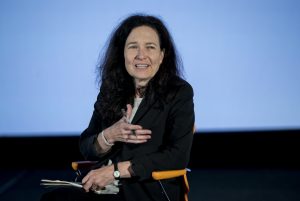
Sally Jo Fifer of ITVS speaking at Getting Real 18. Photo by Mark Hayes.
Erica Ginsberg of Docs in Progress reminded us that Americans for the Arts provides a model for mobilizing and lobbying.
Quinn closed the session with a call to action: “There are big issues coming up and we need to be at the table.”
Where do documentary makers have a stake? In the battles over net neutrality and universal broadband access, including the E-rate for schools and libraries. In opposing media consolidation. In protecting filmmakers here and around the world from arrest, harassment, surveillance and worse. In pressing the FCC to support competition and diversity in the online video marketplace. In defending public funding for independent documentary. In finding new models for sustainable, diverse documentaries that speak truth to power.
Fifer spoke for both sessions when she ended her keynote on an upbeat note: “I feel hopeful because we are a force to be reckoned with when we stand together.”
Larry Kirkman is a producer and writer and former film professor and dean of the School of Communication at American University. Learn more about his current work and career at larrykirkman.com.
